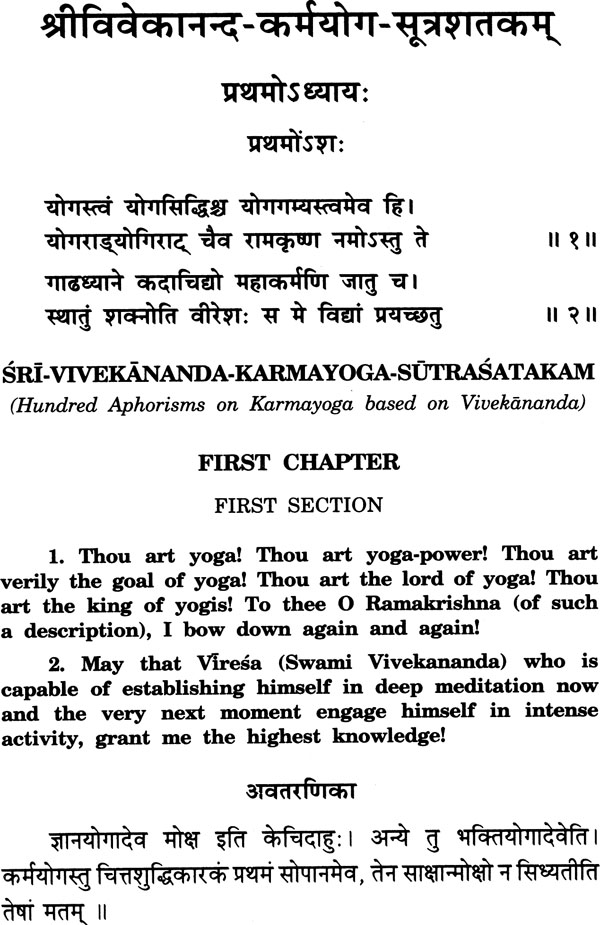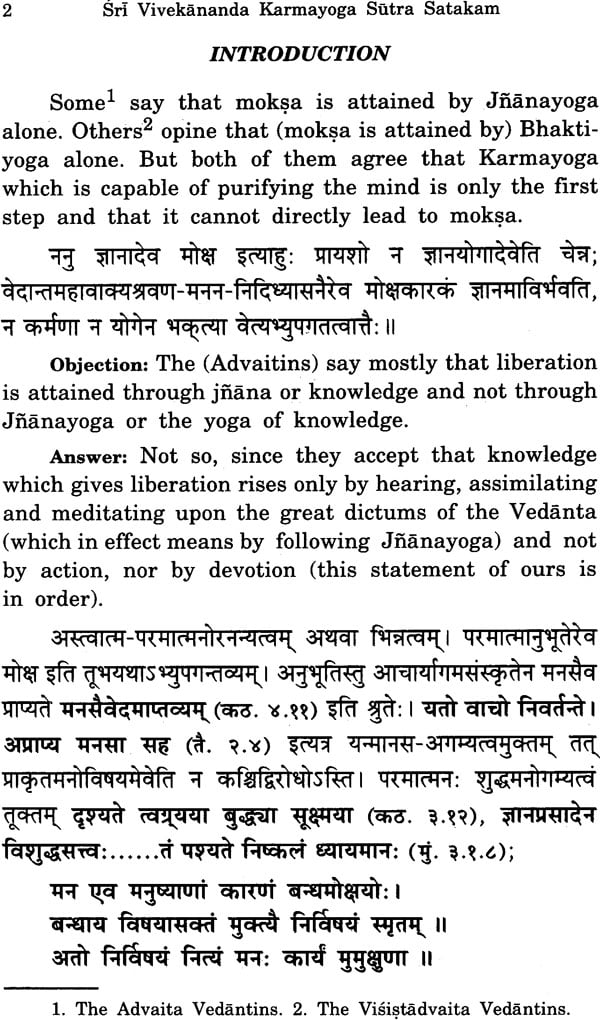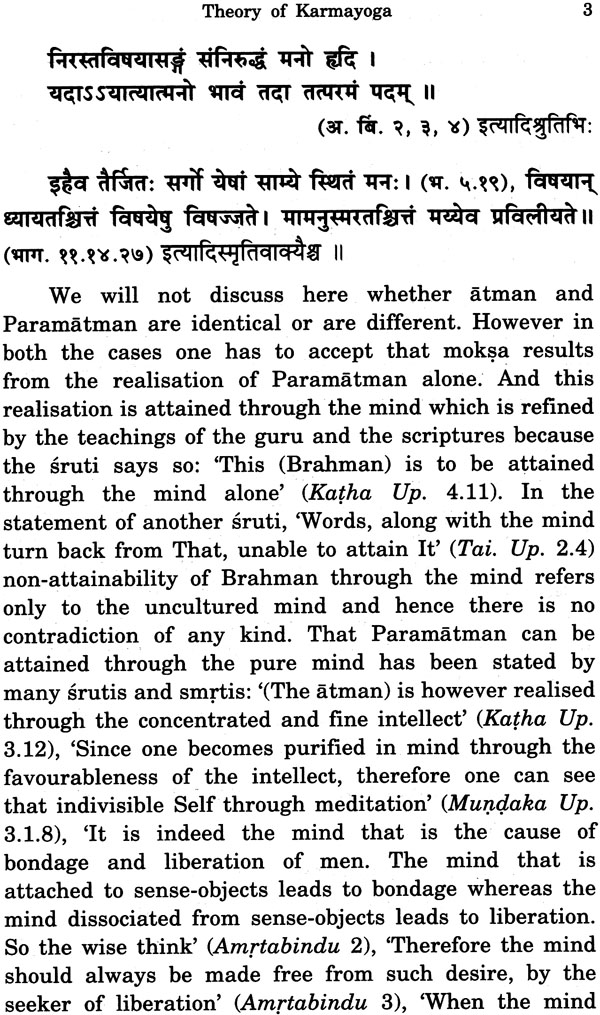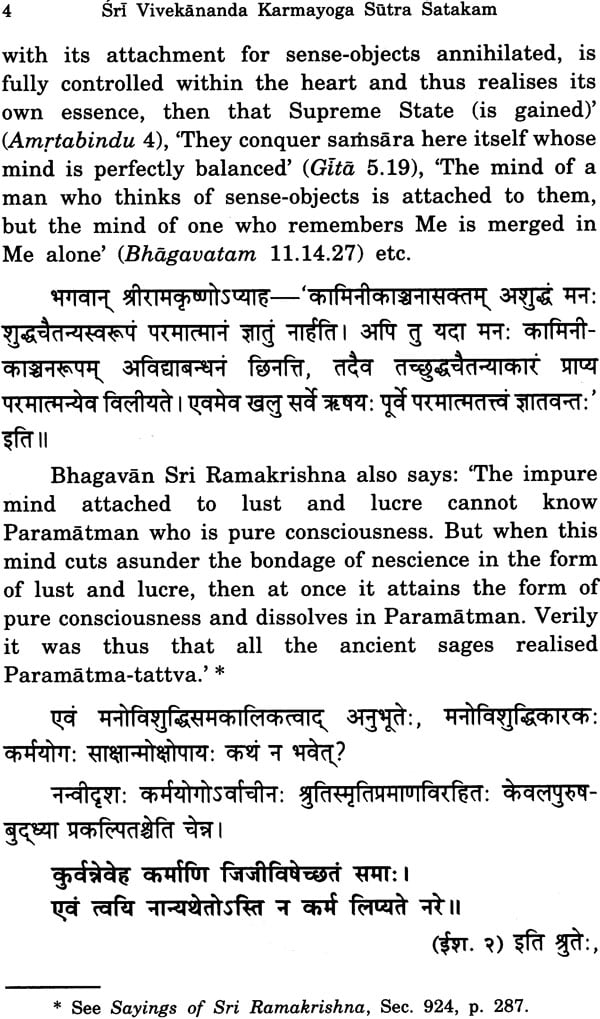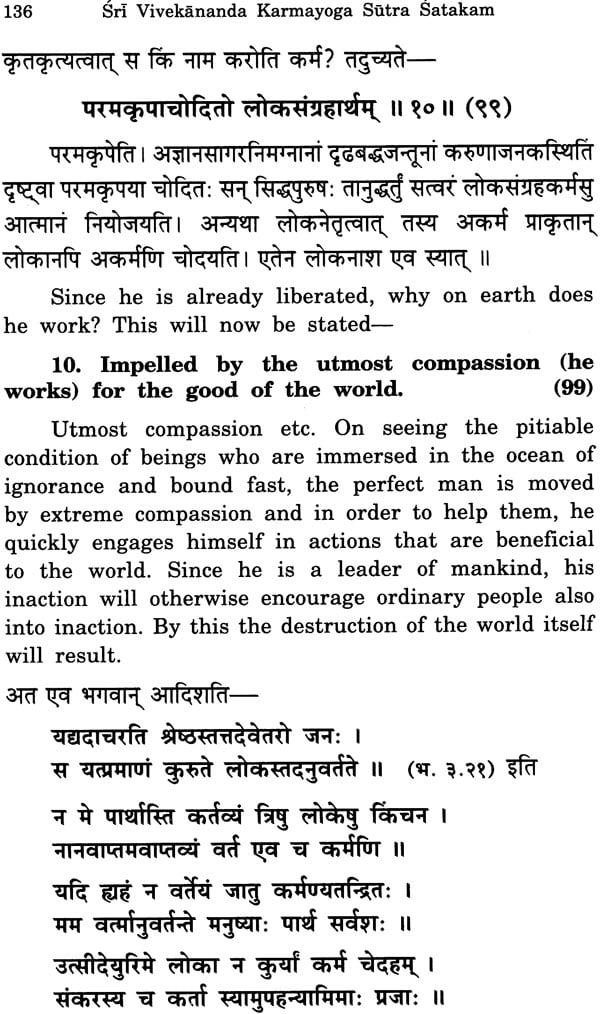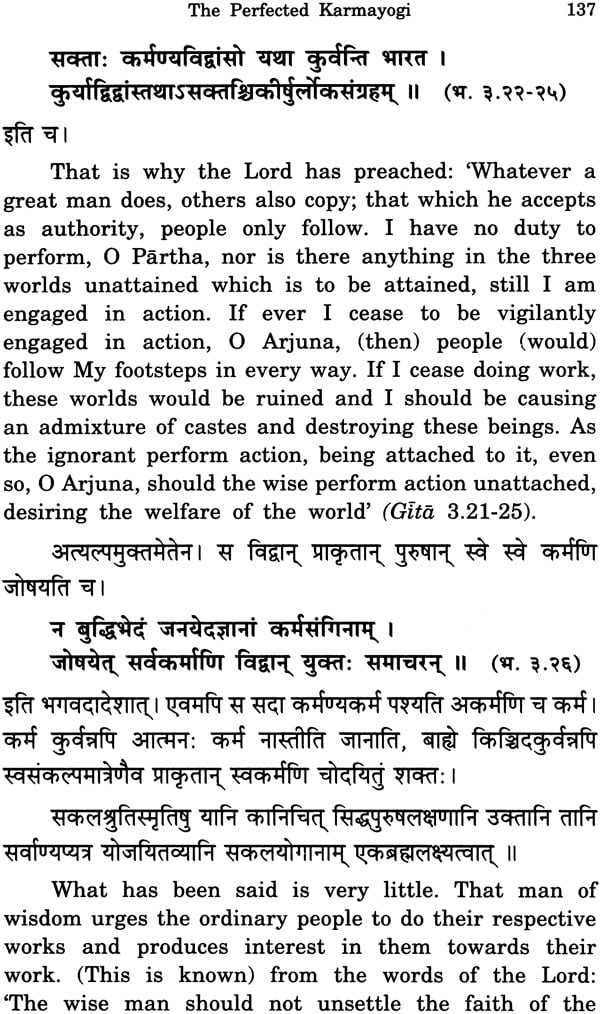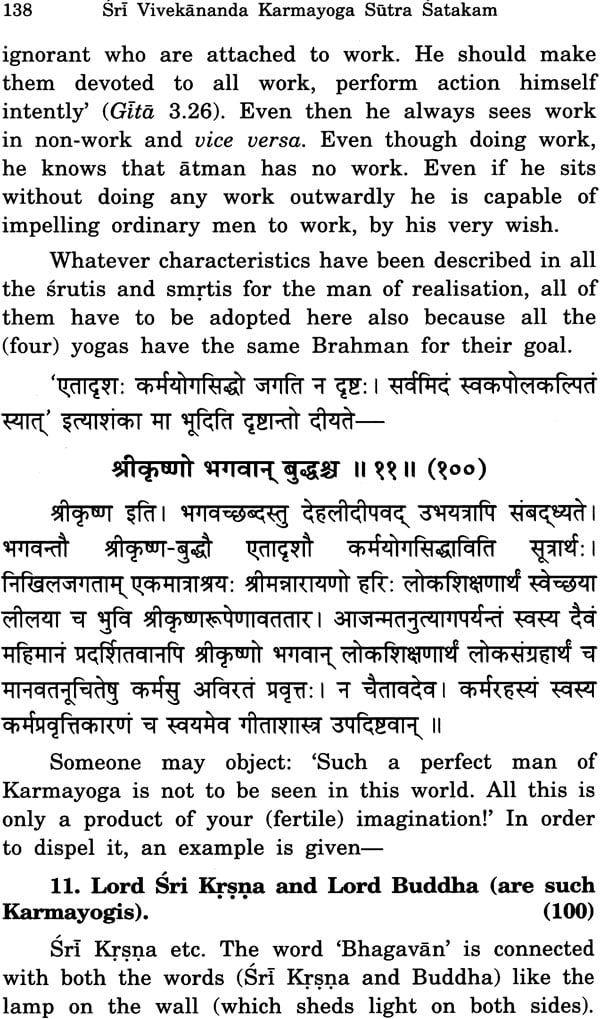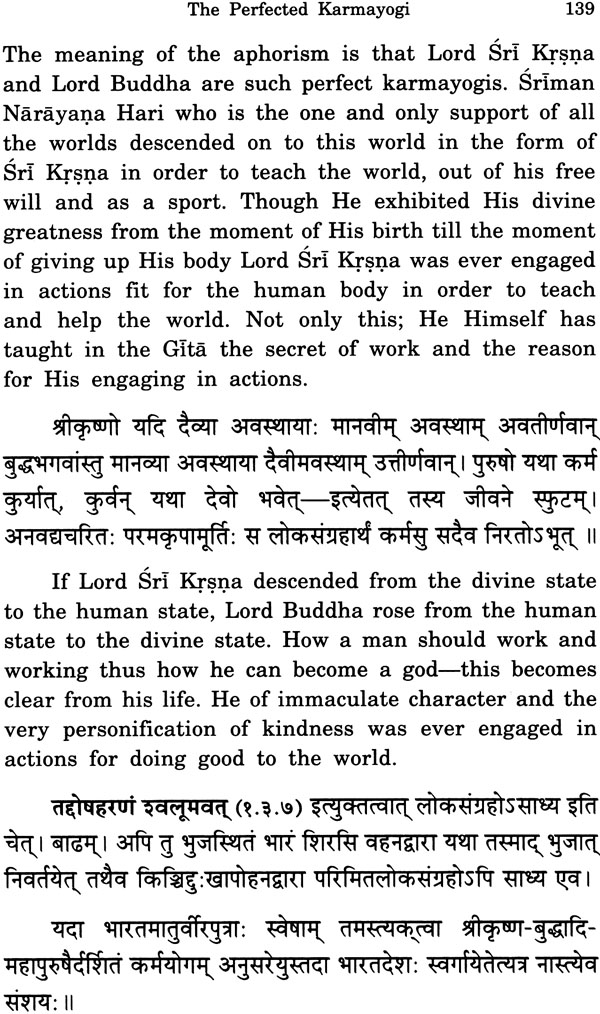
Sri Vivekananda - Karma Yoga Sutra Satakam (Hundred Aphorisms on Karmayoga based on Vivekananda)
Book Specification
| Item Code: | IDE583 |
| Author: | Swami Harshananda |
| Publisher: | Ramakrishna Math |
| Language: | English |
| Edition: | 2019 |
| Pages: | 142 |
| Cover: | Paperback |
| Other Details | 8.5" X 5.7" |
| Weight | 180 gm |
Book Description
It is the considered view of Sri Ramakrishna and Swami Vivekananda that Karmayoga is as much an independent path to perfection as any other yoga. 'Karmayoga is communion with God by means of work'- declares Sri Ramakrishna. Swami Vivekananda asserts that 'The Yogas of work, of wisdom and of devotion are all capable of serving as direct and independent means for the attainment of moksa' and quotes the Gita (5.4) in support. No doubt, the orthodox schools of Vedanta, especially the Advaita, do not subscribe to this view. Despite this fact, it is to be conceded that the great spiritual leaders of the calibre of Sri Ramakrishna and Swami Vivekananda have every right to put forward their own view, born out of intuition and experience.
The eight lectures on Karmayoga by Swami Vivekananda are a classic. In them the theory and practice of Karmayoga, as also the perfect karmayogin, have been described convincingly in a simple but elegant style which goes straight to the heart.
The idea of producing a sutra-work in Sanskrit based on this exquisite treatise of Swami Vivekananda was conceived first in 1962. Next year, during Swami Vivekananda's centenary, the idea was given effect to, though with some trepidation and diffidence.
The work comprises 101 sutras in Sanskrit and is divided into three chapters. Each sutra is preceded by a short introduction and followed by a simple commen- tary, also in Sanskrit. Attempt has been made to cast the sutras and present the commentary in the traditional style, following in the footsteps of similar works. An English translation of both and brief notes have been added for the benefit of those who may not be proficient enough in Sanskrit to understand the original directly.
The first chapter, divided into four sections (arnsas), deals with the theory of Karmayoga. A long introduction has been added at the beginning, giving the outline of the argument in support of the theory that Karmayoga can also directly lead to moksa. The second chapter, divided into three sections, deals with the practice of Karmayoga. The third and the last chapter, the shortest, gives a description of the master karma-yogin.
I am neither a pundit nor a student of philosophy. For this very reason, this work may not satisfy the scholars. As for the devotees and admirers of Swami Vivekananda, his original work is always there to enjoy and be inspired. Then, for whom is this work meant? Well, frankly, I do not know! I consider it as an offering laid at the feet of the great Swamiji during his centenary year. If he accepts this humble offering, my task is done!
Extracts from Reviews:
Swami Harashananda has done a piece of commendable service to the students of philosophy and to the spiritual aspirants, in weaving the great Vivekananda's original thoughts of Karmayoga, into a lovely web of Sutra-satakam... The Sutras of which there are 101, are short, weighty, penetrating utterances, embodying Vivekananda's exposition of the truths of Karma Yoga... In three chapters, Swami Harashananda deals with theory and the practice of Karma Yoga and with the perfected Karmayogi. The book is strewn with apt scriptural quotations which lend an air of sublimity to the exposition....The book is a production of deep understanding and dedicated pious labour.
Vedanta Kesari -July 1978
The book under review is an exposition of Karma Yoga in a hundred aphorisms in Sanskrit and may be designated as the Karma Shastra. ...It is based on the authentic teachings of the great sage of modern times, viz., Sri Ramakrishna and its exposition in eight lectures by Swami Vivekananda. ...The present work holds out salvation as the fruit of Karma Yoga. All points are duly considered in the light of various scriptural statements on which the author bases many of his aphorisms. ... This book... is a contribution of the Ramakrishna Mission to the natural growth of Hinduism. The present author on this account deserves the praise from all kindred souls.
Bhavan's Journal -Vol. 27, no. 4.
(The author) has attempted by these 100 sutras based on Vivekananda's lectures on Karma Marga to epitomise that saint's views about karma being a pathway to moksa. ...Vivekananda's main thrust was against... passive and socially irresponsible inaction. The aphorisms of this publication live true to his directives which were based on a clear perfection of the foibles, natural as well as contrived, to which man's ego is prone. ....The author has closely followed the traditional pattern in the composition of the sutras and in the presentation of the gloss.
The Hindu 19.9.1978
| S.No. | Title | Page no |
| Preface (To the first Edition) | v | |
| Acknowledgement (First Edition -1978) | vii | |
| Abbreviations(Sanskrit) | xi | |
| Key to Transliteration and Pronunciation | xii | |
| FIRST CHAPTER | ||
| Theory of Karmayoga | ||
| First Section: | Introduction and definition of Karmayoga | 1 |
| Second Section: | Definition and nature of atman. Cause of his bondage. Liberation through yoga. Yoga is four-fold, viz., Jnanayoga, Dhyana yoga, Bhaktiyoga and Karmayoga. Definition of each Yoga | 21 |
| Third Section: | Definition and nature of the wold. Sum-total of good and bad is constant Impossible to mend the world. Story of the devil. Utility of Service to others. | 38 |
| Fourth Edition: | Nature of moksa. Can be obtained through Karmayoga. Karma by itself cannot cause bondage or liberation. Karma has to be transcended through karma. All karma is a mixture of good and evil. Karma creates internal impressions. Impressions proportional to att | 49 |
| SECOND CHAPTER | ||
| Practice of Karmayoga | ||
| First Section: | Necessity of the guru. Method of approaching him. Attaining fitness of body, speech and mind. | 88 |
| Second Section: | Should give up prohibited and evil karma. Should also give up kamya-karma. Duties must be performed. Duties due to various causes. Each is great in his own place. Story of the sannyasin, the kingand the sparrows. Definition and method of attaining profici | 99 |
| Third Section: | No yoga can be exclusive. Karmayogi must practise a little of the other yogas also. | 120 |
| THIRD CHAPTER | ||
| The Perfected Karmayogi | ||
| His description. When he chooses to work, he works like a master. Moved by pity he works for the world. Example of Sri Krsna and Buddha. No return to samsara after death. | 126 |
